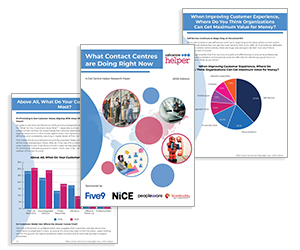This blog summarizes the key points from a recent article from David McGeough at Scorebuddy, where he breaks down 9 key call centre productivity metrics and shows how QA can help you improve each one. From cost per call to chat concurrency, you’ll learn where to focus and what to fix.
This guide will walk you through the core pillars of effective contact centre operations, helping you create a strong foundation for long-term success, for your agents, your customers, and your career.
Call centre operations are in a constant state of transformation. The rise of artificial intelligence, automation, and omnichannel communication has changed how support teams function, all while customer expectations continue to rise.
Yet with all this innovation comes an urgent need for steady leadership and dependable systems. Without it, even the most capable teams can crack under pressure. Poorly managed operations lead to agent burnout, declining service quality, and eventually, lost revenue.
In today’s environment, operational excellence is no longer optional, it’s what separates thriving call centres from struggling ones.
Providing consistency, support, and structure helps teams perform at their best and delivers the experience your customers demand.
The Modern Landscape of Call Centre Management
Call centre management in 2025 is more sophisticated than ever, blending workforce coordination, digital operations, and customer experience strategy. Leaders must juggle performance metrics, agent morale, and omnichannel service delivery.
Today’s managers are expected to support agents through burnout and turnover – two pressing challenges when nearly two-thirds of leaders report difficulty in attracting and retaining talent.
Another crucial shift: real-time analytics and AI-enhanced dashboards are changing how managers work. Strategic decision-making is now tightly tied to data literacy and tech agility.
What Call Centre Leaders Are Tasked With Today
Key responsibilities for modern call centre managers include:
- Forecasting volumes and scheduling across all channels
- Training and mentoring agents on soft skills and compliance
- Tracking KPIs like CSAT, FCR, and AHT across the board
- Supporting hybrid and remote workforce operations
- Utilizing AI-powered tools for QA, analytics, and service improvement
- The specifics often depend on your call centre model:
- Inbound operations focus on quick response and resolution
- Outbound teams rely more on scripting, conversions, and regulatory compliance
- Blended or remote centres demand flexibility, cross-channel coordination, and timezone management
AI is also transforming every part of the process – from predictive forecasting to automated QA – requiring leaders to stay agile in how they lead and deploy tools.
9 Core Areas of Effective Contact Centre Leadership (And How to Get Them Right)
1. Connecting Call Centre Outcomes to Company-Wide Goals
Your contact centre doesn’t exist in a vacuum. Success starts when call centre metrics are directly tied to broader business KPIs like customer lifetime value, churn, and net promoter score.
Clear alignment helps:
- Justify tech or staffing investments
- Guide coaching and evaluation standards
- Cement the call centre’s strategic role
To master it: Map business objectives to agent-level KPIs. Use QA platforms to calibrate and score accordingly, and regularly revisit these metrics as your business evolves.
2. Upgrading Your Workforce Management Playbook
Today’s workforce planning is about more than just filling seats.
Modern WFM solutions rely on AI-powered forecasting, dynamic scheduling, and omnichannel demand modelling – all critical as customer expectations rise across digital and voice channels.
Traditional approaches often lead to:
- Overstaffing or understaffing
- Cost inefficiencies
- Agent disengagement
To improve WFM: Use historical and live data to guide staffing. Integrate tools and allow agents more control over their schedules to support engagement and retention.
3. Building and Keeping a High-Performing Team
Recruiting the right people – and keeping them – is central to call centre success. The right hire has empathy, problem-solving ability, and adaptability.
But hiring alone isn’t enough. Without structured onboarding, upskilling, and a visible career path, your best people will move on. In fact, 62% of agents leave because they don’t see future opportunities.
Get this right by:
- Creating clear growth paths
- Offering consistent coaching and feedback
- Hiring for emotional intelligence, not just resume keywords
4. Creating a Performance Culture Through QA and Coaching
Without solid QA, you’re flying blind. Quality programs provide insights into agent behaviour, compliance, and customer sentiment – and serve as a foundation for agent development.
When connected to effective coaching, QA becomes a tool for growth, not just oversight.
To strengthen QA:
- Use AI to score all interactions, not just a sample
- Create feedback loops from QA into coaching
- Align scorecards with your company and team KPIs
5. Turning Data into Smart Decisions
Contact centres are flooded with data – but collecting it isn’t the same as using it.
From call logs and tickets to agent stats and CSAT feedback, performance analytics fuel smart planning and continuous improvement.
Use analytics to:
- Justify investments or staffing changes
- Detect performance patterns or burnout
- Drive decision-making and show ROI
What to do: Centralize your data, create visual dashboards, and leverage predictive tools to spot trends before they become issues.
6. Leading Remote and Hybrid Teams with Intention
The shift to hybrid and remote work has added layers of complexity to contact centre leadership.
Managers must now navigate time zones, virtual collaboration, and performance tracking without direct oversight – all while keeping teams aligned and engaged.
Remote success depends on:
- Clear expectations and structured communication
- Performance tracking through output, not activity
- Collaboration tools that support real-time connection
To lead effectively: Focus on results, create touchpoints like daily huddles, and use your QA platform to guide development instead of monitoring software.
7. Prioritising the Customer at Every Turn
Customer experience (CX) isn’t just a metric – it’s your call centre’s purpose. Great service doesn’t stop at issue resolution. It considers how customers feel before, during, and after every interaction.
With 85% of consumers willing to go out of their way for better service, CX has real business value.
To elevate CX:
- Collect and act on sentiment data
- Use QA and survey feedback to fine-tune scripts or processes
- Empower agents to deliver empathy, not just efficiency
8. Adopting Smart Tech and Automation
Tech-driven innovation is no longer optional. Whether you’re auto-scoring calls, summarizing chats with AI, or streamlining workflows, these tools increase capacity while improving experience.
Outdated systems lead to:
- Workflow inefficiencies
- Agent frustration
- Inconsistent support quality
Lead the tech shift by:
- Piloting AI tools that fit your workflows
- Automating low-complexity tasks
- Gathering feedback from agents on usability and pain points
9. Ensuring Compliance and Managing Risk Proactively
Compliance is non-negotiable in regulated industries – and mistakes can be costly. Managers must ensure every conversation and system adheres to laws like TCPA, PCI-DSS, or HIPAA.
Strong compliance programs:
- Educate agents on relevant laws and policies
- Use QA to flag risk-prone behaviours
- Audit processes to stay ahead of threats
To get it right: Build a culture of accountability. Run regular compliance checks, and use your QA insights to coach and improve before small issues become large violations.
How to Grow as a High-Impact call centre Leader
Ready to take your leadership further? Here are 8 ways to stand out and build long-term impact:
- Lead with empathy: Recognize team emotions, especially during pressure. Empathetic leadership builds trust and boosts morale.
- Understand your metrics: Focus on business-driving KPIs – CSAT, FCR, QA – and use them to influence decision-makers.
- Break silos: Partner with marketing, IT, HR, and product to streamline systems and shape customer outcomes.
- Communicate effectively: Whether giving feedback or pitching an idea, make sure your message is clear, confident, and data-informed.
- Think long-term: Don’t just react – plan. Strategize around growth, loyalty, and operational efficiency.
- Stay sharp: Constantly learn. Keep up with trends in CX, AI, and call centre leadership.
- Mentor your team: Develop leadership at every level by mentoring, promoting from within, and recognizing talent.
- Be the voice of change: Champion tools and process updates. Leaders who drive change position themselves for growth.
This blog post has been re-published by kind permission of Scorebuddy – View the Original Article
For more information about Scorebuddy - visit the Scorebuddy Website
Call Centre Helper is not responsible for the content of these guest blog posts. The opinions expressed in this article are those of the author, and do not necessarily reflect those of Call Centre Helper.
Author: Scorebuddy
Reviewed by: Rachael Trickey
Published On: 7th Aug 2025
Read more about - Guest Blogs, Scorebuddy






 Scorebuddy is quality assurance solution for scoring customer service calls, emails and web chat. It is a dedicated, stand-alone staff scoring system based in the cloud, requiring no integration.
Scorebuddy is quality assurance solution for scoring customer service calls, emails and web chat. It is a dedicated, stand-alone staff scoring system based in the cloud, requiring no integration. 































